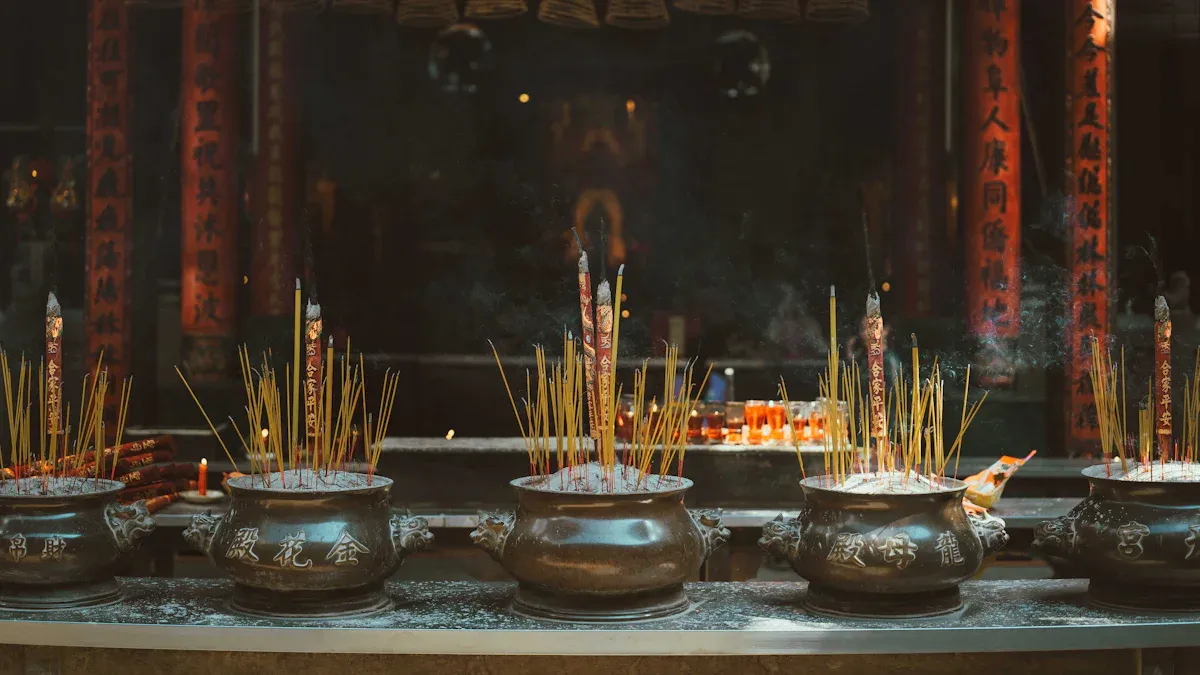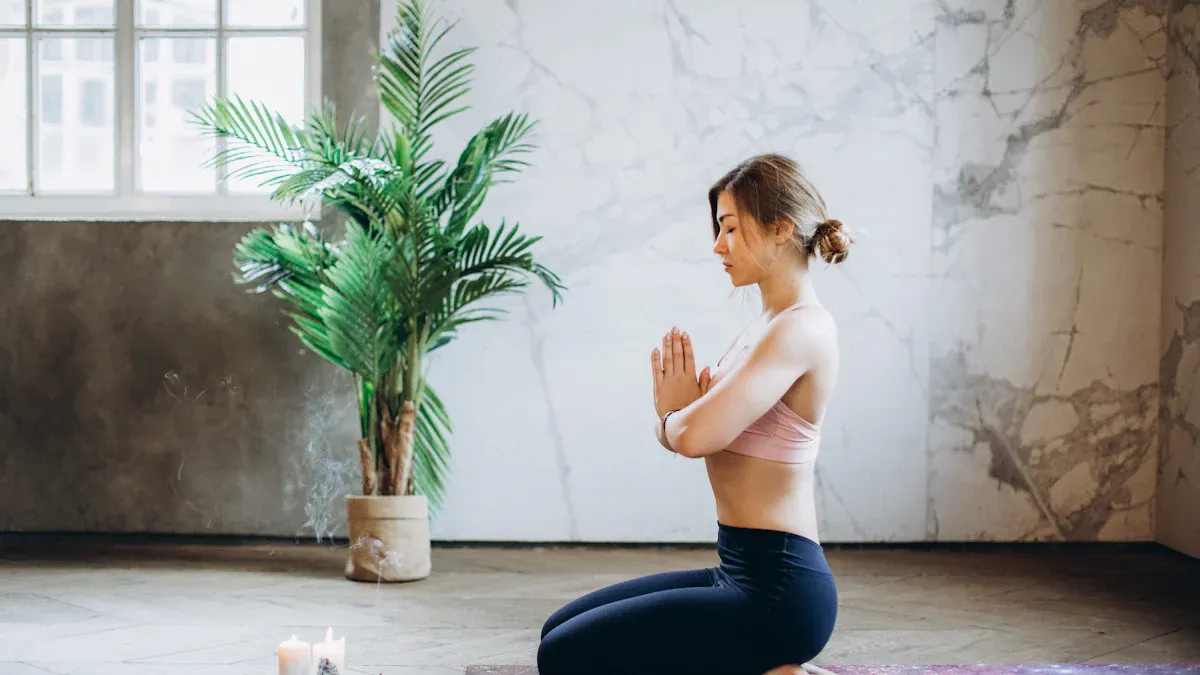
From Ancient Rituals to Modern Mindfulness: The Story of Incense
Share
You hold incense and join a tradition from long ago. This tradition started in Egypt, Mesopotamia, and China. The table below shows how incense was used:
| Civilization | Evidence |
|---|---|
| Ancient Egypt | Resin balls found in tombs, incense burners, and temple carvings |
| Mesopotamia | Plants and resins burned during rituals |
| Ancient China | Herbs and plants used in special ceremonies |
Today, incense is found in many wellness places. People like its calming effect. They also connect it to mindfulness. The incense market grows every year. This is because wellness culture is getting more popular.
Key Takeaways
- Incense has a long history. People used it in old rituals. It was for spiritual and health reasons. Many cultures like Egypt, China, and India used it. Lighting incense can help with meditation. It can make you feel calm. It helps lower stress. Using incense every day connects you to old traditions. It also helps you feel good and relaxed.
Incense Origins and Cultural Significance

Ancient Rituals and Early Uses
Incense has been used for thousands of years. Ancient Egypt, China, and India used incense for many reasons. People burned plants and resins in simple rituals. They wanted to honor gods, clean spaces, and help heal bodies. In Egypt, incense was important in temples and daily offerings. Priests mixed blends like Kyphi for gods and sacred places. Old writings show recipes for incense. These rituals were very important.
Here is a table showing how different cultures used incense in early rituals:
| Culture | Spiritual Purpose | Medicinal Purpose |
|---|---|---|
| Ancient China | Used for religious and ceremonial purposes | N/A |
| India | Used in sacred rituals, believed to purify and ward off negative energies | Used to balance doshas and improve mental clarity |
| Ancient Egypt | Purified homes and temples, warded off evil spirits | Used in medical treatments and embalming practices |
| Greeks/Romans | Honored gods and warded off illness | Purified air and treated respiratory ailments |
| Traditional Chinese Medicine | Incorporated in treatment protocols | Treated conditions like asthma and anxiety |
Different cultures made incense with special ingredients. Egyptians used frankincense and myrrh. People in China burned sandalwood and cypress. In India, incense was used in yajnas and pujas. It was believed to send prayers to the sky. The trade of incense linked Egypt, Mesopotamia, and the Indus Valley. This helped people share ideas and beliefs. These exchanges shaped the culture of these places.
Eastern Breath Art and Incense Sticks
East Asia has a tradition called "breath art" with incense. Incense sticks started in ancient China and India. In these places, incense became more than a ritual tool. It turned into an art that connects breath, mind, and nature. Lighting an incense stick starts a journey for your senses. The smoke helps you slow down and think.
Eastern traditions teach you to "listen" to incense. In Japan, kodo means paying attention to the smell. You let the scent guide your thoughts. There is a Japanese saying:
“The traditional Japanese rituals all say to ‘listen’ to the incense... It’s not important what you hear. It’s only important that you listen. The way of incense is a path to stillness, and stillness is the path to heaven.”
Incense became part of rituals and ceremonies in East Asia. Buddhism made incense sticks important for religion and meditation. The rules for enjoying incense grew with tea ceremonies. This shows how important incense is in these cultures. In Japan, people have incense ceremonies. They play games and guess the scents. This tradition shows how incense can change people.
Incense in Religious and Daily Life
Incense is used in daily life and religious events around the world. In ancient Egypt, incense was burned every day in temples. It invited gods and cleaned the air. In India, incense is used in pujas and prayers. It makes the space feel sacred. Incense is part of Hindu and Buddhist rituals in India. It stands for devotion, cleaning, and connecting to the divine.
Here is a table showing how incense is used in different cultures:
| Culture | Use of Incense |
|---|---|
| Ancient Egypt | Integral to temple ceremonies, funerary rites, and divine offerings; believed to carry prayers to the heavens. |
| East Asia | Used in Buddhist, Taoist, and Shinto ceremonies for purification and summoning deities. |
| Native Americans | Smudge sticks used in sacred rituals and cleansing ceremonies. |
| India | Ubiquitous in daily worship and pujas, with offerings made to deities like Krishna and Rama. |
Incense ceremonies mark special times in life. Incense has different meanings in each culture. In Hinduism, it means cleaning and devotion. In Buddhism, incense helps with mindfulness and reaching higher states. Christianity uses incense to show prayers going up to heaven. Incense is important because it connects the spiritual and physical worlds.
Incense is also used for practical things. People use it to freshen breath, calm their minds, and help with sickness. The history of incense shows how it became part of daily life and religion. People still follow these old traditions today. The story of incense sticks and rituals shows many beliefs and customs. Incense in the Middle East, East Asia, and India shows how rich and varied human culture is.
Lighting incense connects you to old traditions. The smell reminds you of shared human history. Incense is still a strong symbol of spirituality, healing, and culture.
Evolution and Modern Mindfulness

Cultural Significance of Incense Types
Incense comes in many shapes today. Each kind has its own meaning. Stick incense is used in many ceremonies and for wellness. Cone incense is often used when people meditate. Coil incense burns for a long time in rituals. Loose incense needs to be prepared before use. Resin incense is made from tree sap and links to old healing rituals. The table below shows how each incense type connects to culture:
| Type of Incense | Cultural Significance |
|---|---|
| Stick | Used in religious ceremonies and wellness practices |
| Cone | Popular in meditation practices |
| Coil | Used in rituals, long-lasting burn |
| Loose | Spiritual practices, requires preparation |
| Resin | Ancient rituals, healing properties |
Chinese incense uses ground-up plants and shows respect for nature. In India, sandalwood and frankincense show the region’s culture. Today, incense mixes essential oils with old ways. This brings together tradition and new tastes.
Incense in Meditation and Wellness
Incense can help make a calm space for meditation. Scents like lavender and sandalwood help you relax and focus. Studies show incense can calm your body and mind. It lowers stress and helps you be mindful. Many people use incense for yoga and aromatherapy. You can also use sprays or oils to make the space better. Burning incense helps you feel balanced and calm.
Tip: Burn incense while meditating to help you focus and feel better.
Contemporary Personal Rituals
You can add incense to your daily habits. People use it for meditation, yoga, and feeling good. Scents like frankincense and jasmine help you feel calm. Incense is also used in big celebrations like Diwali and Chinese New Year. Today, people like incense because it lifts their mood and brings back memories. It also helps them feel close to old traditions. Lighting incense keeps the history alive and supports your well-being.
Incense is a tradition that connects people to the past. Many cultures use incense to relax and meditate. It also helps make spaces feel special. Scents like sandalwood and frankincense help you feel peaceful. Lighting incense honors old customs and makes your day better.
FAQ
What is incense made from?
Incense uses things from nature. Makers use wood powders, resins, herbs, and essential oils. They mix these to make many scents.
How do you use incense safely?
Put incense on a holder that does not burn. Keep it far from things that catch fire. Do not leave incense burning alone.
Can incense help you relax?
Incense can make your space feel calm. Many people think some scents help them feel peaceful and pay attention.
